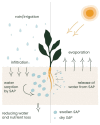The Role of Superabsorbent Polymers and Polymer Composites in Water Resource Treatment and Management
- PMID: 39204557
- PMCID: PMC11358950
- DOI: 10.3390/polym16162337
The Role of Superabsorbent Polymers and Polymer Composites in Water Resource Treatment and Management
Abstract
In the last century, the issue of "water reserves" has become a remarkably strategic topic in modern science and technology. In this context, water resource treatment and management systems are being developed in both agricultural and urban area scenarios. This can be achieved using superabsorbent polymers (SAPs), highly cross-linked hydrogels with three-dimensional, hydrophilic polymer structures capable of absorbing, swelling and retaining huge amounts of aqueous solutions. SAPs are able to respond to several external stimuli, such as temperature, pH, electric field, and solution composition and concentration. They can be used in many areas, from sensor technology to drug delivery, agriculture, firefighting applications, food, and the biomedical industry. In addition, new categories of functional SAP-based materials, mainly superabsorbent polymer composites, can also encapsulate fertilizers to efficiently provide the controlled release of both water and active compounds. Moreover, SAPs have great potential in wastewater treatment for the removal of harmful elements. In this respect, in the following review, the most promising and recent advances in the use of SAPs and composite SAPs as tools for the sustainable management and remediation of water resource are reviewed and discussed by identifying opportunities and drawbacks and highlighting new challenges and aims to inspire the research community.
Keywords: superabsorbent polymers; urban water management; water resource.
Conflict of interest statement
The authors declare no conflicts of interest.
Figures





References
-
- Tomlinson I. Doubling Food Production to Feed the 9 Billion: A Critical Perspective on a Key Discourse of Food Security in the UK. J. Rural. Stud. 2013;29:81–90. doi: 10.1016/j.jrurstud.2011.09.001. - DOI
-
- Nasser A.A., Rashad M.Z., Hussein S.E. A Two-Layer Water Demand Prediction System in Urban Areas Based on Micro-Services and LSTM Neural Networks. IEEE Access. 2020;8:147647–147661. doi: 10.1109/ACCESS.2020.3015655. - DOI
-
- Mishra A.K., Singh V.P. A Review of Drought Concepts. J. Hydrol. 2010;391:202–216. doi: 10.1016/j.jhydrol.2010.07.012. - DOI
-
- Geng S.M., Yan D.H., Zhang T.X., Weng B.S., Zhang Z.B., Qin T.L., Yan Á.D.H., Weng B.S., Zhang Á.Z.B., Zhang T.X. Effects of Drought Stress on Agriculture Soil. Nat. Hazards. 2015;75:1997–2011. doi: 10.1007/s11069-014-1409-8. - DOI
-
- Jiménez-Rosado M., Alonso-González M., Rubio-Valle J.F., Perez-Puyana V., Romero A. Biodegradable Soy Protein-Based Matrices for the Controlled Release of Zinc in Horticulture. J. Appl. Polym. Sci. 2020;137:49187. doi: 10.1002/app.49187. - DOI
Publication types
LinkOut - more resources
Full Text Sources
Miscellaneous

